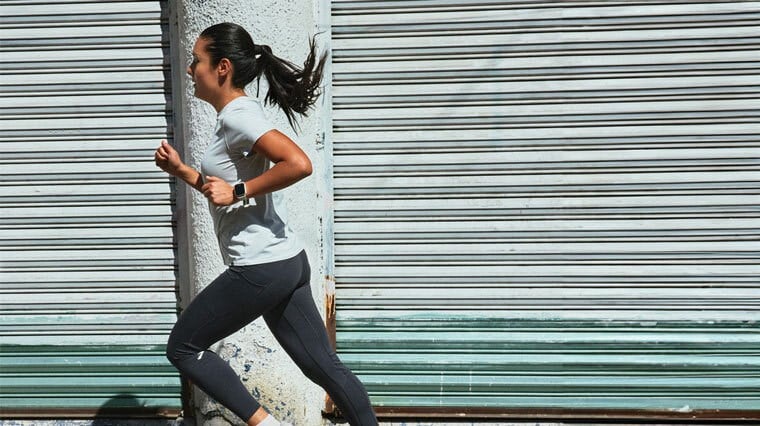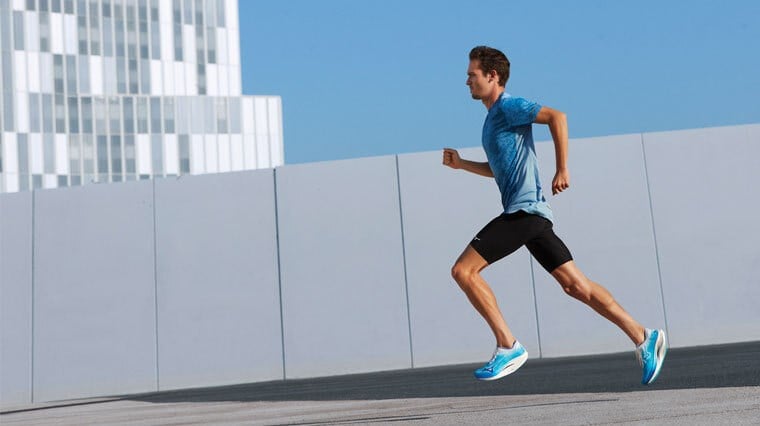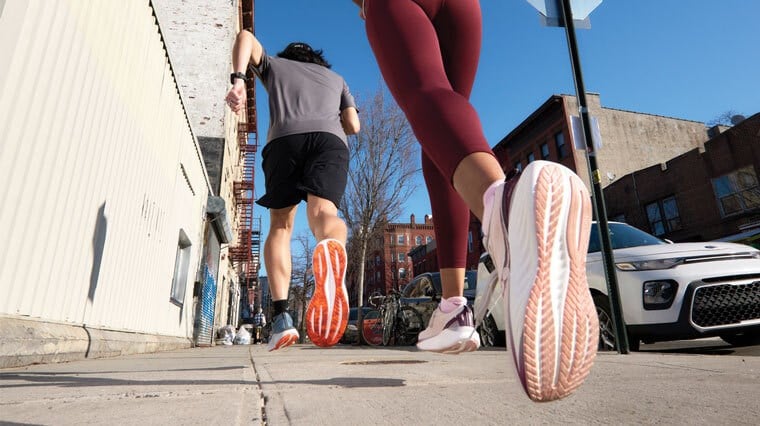How To Improve Your Running Form From Head To Toe

There isn't a perfect one-size-fits-all correct running form, because you’re unique and so is your natural biomechanics, the way you move.
If you’re an experienced runner that usually runs free of aches, pains and injury, chances are you’ve found what works for you and trying to make significant changes may actually decrease your running efficiency and speed.
However, if you’re a beginner runner learning the ropes or running is causing you pain, niggles or twinges in your muscles, these essential running form tips will help prevent injury and improve your running efficiency.
If you've ever wondered "How do I know if I'm running properly?", this must-read guide will answer your questions, helping you make the most of every marathon and running plan.
Alongside reducing your risk of injury and increasing your efficiency to run longer with less fatigue, understanding why running form is important and committing to improving your running technique can make you a faster runner.
Let’s work from the head down to achieve proper running form for beginners, proper running form for marathon and to ensure you aren't making the common mistakes in your running posture and technique.
Head: How should your head be when running?
As eye-catching as your new running shoes are, don’t stare at your feet while you run. Always look forwards, keeping your head level. It may help to imagine a string attached to your head being pulled up by a giant puppeteer to promote good posture.
Naturally scan the horizon with your chin parallel to your running surface and slightly tucked in – not too far as it may restrict your airway, and not jutting out as it’ll cause tension in your neck.
If you need a further cue for proper running posture in your head and neck, look approximately 3 - 6 metres (10 - 20 feet) in front of you. This will guide your head and neck into a neutral position, while keeping you aware of potential obstacles in your path.
Shoulders: How do I stop my shoulders tensing when I run?
Feel your shoulders creeping up? Having them high and tight is a sign of tension and it’s common when your muscles become fatigued over a long distance run.
You don’t want tension keeping you from your runner’s high, so take a moment to gently circle your shoulders to release tension, or deeply inhale then exhale to encourage relaxation. This will allow you to focus your energy efficiently back into your run.
Keep your shoulders relaxed and loose, not slouched or scrunched towards your ears. Avoid a side to side swaying motion – your shoulders should remain level.
Arms: Why do we swing our arms when running?

Your arms propel your run forward, swinging like a pendulum from your shoulder joint. Their forward and back motion should be naturally in sync with the running stride of the opposite leg, acting as a counterbalance. This movement is referred to as arm drive, and can help control the pace and power of your run.
Avoid your arms crossing over your midline as this can interfere with your balance. Keep your elbows at about a 90 degree angle (a little less is OK) with arms between the level of your waist and chest as they smoothly pump by your sides. They should remain close to your body, with compact movements to conserve energy.
Hands: Should your hands be open or closed when running?
That depends. During long distance or slow running sessions, many runners benefit from keeping their hands softly clenched. Imagine you’re holding a potato chip gently cupped in your hand, with your fingertips just touching the inside of your palm, allowing your hands to remain relaxed. Don’t clench your fists tightly, as this will increase tension up your forearm that can hinder your comfort, running efficiency and jeopardise your arm swing.
During sprints, it may be beneficial to keep your hands open and relaxed, optimising arm drive to promote propulsion. In both situations, a relaxed hand position is key to support your comfort and running performance.
Torso: How to not slouch when running

A straight torso improves your lung capacity and encourages an optimal stride length for running while minimising risk of injury to your back and lower body. If your head and shoulders are in proper running form, your torso should naturally follow in line.
The ‘run tall’ mantra encourages an upright posture. You can use a simple breathing exercise before your run, following a walking break and when you’re feeling fatigued to achieve this.
Inhale deeply and maintain that posture as you exhale, allowing your breathing to guide your body and to keep your head, shoulders and hips in proper alignment.
Hips: What is the correct hip posture for running?
Your hips aren’t just for setting a new hula hoop record - they’re a critical component of proper running posture as your body’s centre of gravity. If you’re following our above tips regarding your upper body, particularly head, shoulders and torso, they should naturally be in correct alignment, stable and pointed straight ahead.
An excessive forward lean from the hips can throw you off balance and increase impact forces on your body, while leaning back may result in overstriding and heavy heel landings, putting strain on your back, hips and knees.
A slight lean promotes running efficiency, but it should be from the ankles, not the hips or waist. This will aid in keeping your body in alignment. Although this can occur without conscious effort, some runners find it tricky to master – it helps to be aware of how you’re shifting your weight as you run to identify if you’re leaning correctly.
Knees: Are you supposed to bend your knees when running?
"What is the best running form for knees?" is a common question among runners, and the answer can come down to whether you are a long distance runner or sprinter. Endurance runners and marathoners generally conserve energy by low, quick knee lifts and benefit from a short stride to minimise strain on the muscles, protecting the injury-prone knee joint. On the other hand, sprinters use high knee lifts to generate speed and power for explosive movement.
Your knees are natural shock absorbers. Keep them slightly bent (about 20 degrees upon landing) and soft to ensure smooth impacts and maximum comfort throughout the repetitive motion of running. This will reduce the degree of stress running through your leg joints and lower back, helping reduce your risk of injury over long distances.
Feet: How to land softly when running

Aim to run with a short, virtually soundless stride. This way, you'll run light on your feet, 'floating' more softly over the pavement to protect your body from impact stresses.
Many runners ask, "Should you run heel to toe?" or "How should your feet hit the ground when running?". There is no inherently wrong or right foot strike, and the best advice is to run in a way that is comfortable for you.
For heel strikers, this may mean investing in running shoes that provide adequate cushioning in this high-impact zone, like the Asics Gel Cumulus, Saucony Ride or Adidas Adizero Adios Pro for neutral runners, and the Asics Gel Kayano and Brooks Adrenaline GTS for overpronators requiring additional stability.
Rather than focusing on your foot strike (forefoot, midfoot or heel strike), consider where your foot lands in relation to your body. Your feet should impact the ground directly beneath your hips/knees for a smooth gait.
Your running cadence, the number of times your feet strike the ground per minute, may naturally improve as a result, as opposed to overstriding. Overstriding refers to when your feet strike the ground excessively in front of your body, creating a lengthened, choppy gait and fewer strides per minute.
Overstriding is a frequent mistake among beginner runners trying to cover too much ground in one stride, acting as a break in your momentum and increasing risk of injury as you land harder on the pavement.
Any significant changes to your running form should occur gradually to allow your muscles to adapt smoothly and without injury. A running coach can provide you with personalised guidance.
Happy running!


